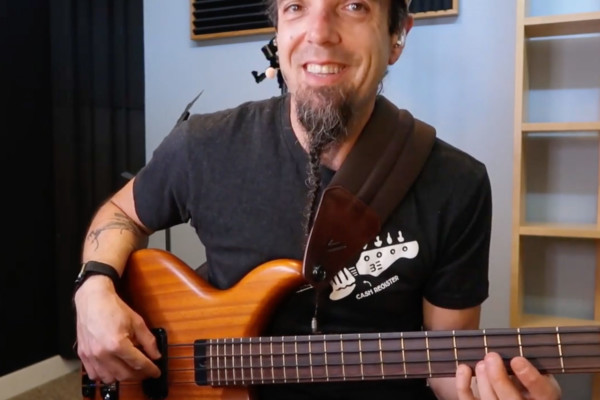Ask Damian Erskine: Playing with and around the beat
Q: What is and how do you play behind or ahead of the beat? Is it just rushing or dragging?
A: Good time is an obvious starting point. A great bass player is in control of their internal clock. You should be adept at playing dead ON the beat, pulling behind, pushing ahead and everywhere in between. Playing behind the beat or playing on top of the beat is NOT slowing down or speeding up!!!! It’s fairly microscopic in scope and has more to do with feel than anything. There will be times when a song is started too slow or fast and someone may gesture to speed up or slow down, this isn’t what I’m talking about.
An exercise I’ve always had fun with is this:
- Set a metronome to 90 or 100bpm and either play just ONE note or mute your strings and just play rhythm.
- Start by simply playing exactly ON the beat (the click may actually disappear if you nail it just right!)
- Do this for a while and try and make your line as funky as you can… have fun with it. (I’ve also stopped here frequently and this is how I play with different rhythms and try and internalize or experiment with rhythm. We’ll do something else here for the purpose of this exercise)
- Try and sub-divide the beat any which way you can (play triplets, 16ths, try and play 5 beats over the click in 4, 3 over 4, etc… )
- Now experiment with making the line sound lazy without ever losing the click. Make it sound like your playing behind the beat ever so slightly without straying from it.
- Do the same thing but push the rhythms just a hair without straying from the beat.
It’s a microscopic change, so small that you never lose the tempo, BUT the line FEELS different.
Sometimes if I think I need to play behind the beat, I’ll think lazily and play the groove lazily but ALWAYS make sure that I’m right there on the one with the drummer (assuming that your drummer has great time, too and you don’t just make him drag). Same thing goes for playing on top of the beat.
It takes finesse, control and a strong internal clock. If you lose the click or change tempo, take a step back and first master playing ON the beat. Dead-on… just nail that thing.
A good exercise I’ve done (and heard many other bass players demonstrate as well) is to start with a click moving pretty quickly. Play a bass line, or just play a rhythmic pattern as stated before and LOCK it in. Now cut the click in half and play the same thing. Are you still nailing the down-beat of every bar? Cut it in half again!
Can you still nail the downbeat every 4 bars?
Cut it down AGAIN!! Can you play a line with the click only playing the first beat of every 8 bars?!
You can also do this with other beats in the bar. It doesn’t have to be the one and, in fact, if you play with this idea, it’ll help to internalize time even more.
Play with the click just on the and of 2 every bar. Every 4 bars.. PLay with the click on the upbeats instead of the downbeats.
Play with the click on the upbeat of beats 2 and 4 (2-and & 4-and).
You can subdivide it further and play with the click on any part of the beat. divided by 16ths? Play with the click on 1-e (as in 1-e-&-a, 2-e-&-a, 3-e-&-a, etc…
These type of exercises are some of the best internal clock exercises you can do. Just don’t try and get too fancy until you’ve got the basics down!!
Have a question for Damian? Ask him!
Check out more Ask Damian Erskine columns
Have a question for Damian Erskine? Send it to [email protected]. Check out Damian’s instructional books, Right Hand Drive and The Improviser’s Path.



